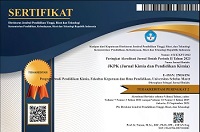Analysis of General Chemistry Textbooks Based on Multiple Representations of the Cell Potential Concept
Abstract
Textbooks function as core learning resources in chemistry, particularly for explaining abstract ideas through visual representations. This study examines how the concept of electrochemical potential cells is represented in five college level general chemistry textbooks using five analytic criteria covering representation type, explicitness, connectedness, information sufficiency, and conceptual relatedness. The sample comprises widely adopted texts that span foundational topics to ensure relevance across common curricula. The analysis identified a distinct pattern within each category. Category C1 was dominated by symbolic representations at 74.7 percent. Category C2 showed predominantly explicit presentations at 79.3 percent. Category C3 reflected fully related and connected representations. Category C4 demonstrated complete presence of appropriate information at 100 percent. Category C5 included three levels of conceptual relatedness with quite related at 74.2 percent, not quite related at 19.4 percent, and not related at 6.5 percent. The findings outline the current quality of visual representations of potential cells in higher education materials and indicate areas where integration across macroscopic, submicroscopic, and symbolic levels could be strengthened. Educators, textbook authors, and curriculum developers can apply these insights to design materials that support deeper conceptual understanding and more coherent transitions between representations.
Keywords
Full Text:
PDFReferences
[1] V. Gkitzia, K. Salta, and C. Tzougraki, “Development and application of suitable criteria for the evaluation of chemical representations in school textbooks,” Chem. Educ. Res. Pract., vol. 12, no. 1, pp. 5–14, 2011, doi: 10.1039/C1RP90003J.
[2] K. Dimopoulos, V. Koulaidis, and S. Sklaveniti, “Towards an analysis of visual images in school science textbooks and press articles about science and technology,” Res. Sci. Educ., vol. 33, pp. 189–216, 2003, doi: 10.1023/A:1025006310503.
[3] A. H. Johnstone, “The development of chemistry teaching: A changing response to changing demand,” J. Chem. Educ., vol. 70, no. 9, pp. 701–705, 1993, doi: 10.1021/ed070p701.
[4] X. Chen, L. F. de Goes, D. F. Treagust, and I. Eilks, “An analysis of the visual representation of redox reactions in secondary chemistry textbooks from different Chinese communities,” Educ. Sci., vol. 9, no. 1, p. 42, 2019, doi: 10.3390/educsci9010042.
[5] J. K. Gilbert, O. de Jong, R. Justi, D. F. Treagust, and J. H. van Driel, Eds., Chemical Education: Towards Research-Based Practice. Dordrecht, The Netherlands: Kluwer/Springer, 2003.
[6] P. J. Garnett and D. F. Treagust, “Conceptual difficulties experienced by senior high school students of electrochemistry: Electric circuits and oxidation–reduction equations,” J. Res. Sci. Teach., vol. 29, no. 2, pp. 121–142, 1992, doi: 10.1002/tea.3660290204.
[7] S. N. Afifah, L. Mahardiani, and B. Utami, “A content analysis of pictorial material in the chemistry textbooks on the topic redox reaction based on chemical representation,” JKPK (Jurnal Kimia dan Pendidikan Kimia), vol. 8, no. 1, 2023, doi: 10.20961/jkpk.v8i1.72885.
[8] T. Widhiyanti and N. Islahiah, “Multi-representation analysis of general chemistry books on chemical bonding subject,” Orbital: J. Pendidikan Kimia, vol. 8, no. 1, pp. 61–70, 2024, doi: 10.19109/ojpk.v8i1.21609.
[9] S. S. Shehab and S. BouJaoude, “Analysis of the chemical representations in secondary Lebanese chemistry textbooks,” Int. J. Sci. Math. Educ., vol. 15, no. 5, pp. 797–816, 2017, doi: 10.1007/s10763-016-9720-3.
[10] J. R. Fraenkel and N. E. Wallen, How to Design and Evaluate Research in Education, 7th ed. New York, NY, USA: McGraw-Hill, 2008.
[11] C.-Y. Lin and H.-K. Wu, “Effects of different ways of using visualizations on high school students’ electrochemistry conceptual understanding and motivation towards chemistry learning,” Chem. Educ. Res. Pract., vol. 22, no. 3, pp. 786–801, 2021, doi: 10.1039/D0RP00308E.
[12] M. J. Sanger and T. J. Greenbowe, “Students’ misconceptions in electrochemistry: Current flow in electrolyte solutions and the salt bridge,” J. Chem. Educ., vol. 74, no. 7, pp. 819–823, 1997, doi: 10.1021/ed074p819.
[13] H.-J. Schmidt, M. Marohn, and H.-A. Göhring, “Factors that prevent learning in electrochemistry,” J. Res. Sci. Teach., vol. 44, no. 2, pp. 258–283, 2007. doi: 10.1002/tea.20118.
[14] J. Surif, P. Loganathan, N. H. Ibrahim, N. S. Serman, and A. M. Alwi, “Effect of inductive teaching method to improve science process skills in electrochemistry,” in Proc. IEEE Int. Conf. Teaching, Assessment, and Learning for Engineering (TALE), Yogyakarta, Indonesia, Dec. 2019, pp. 422–429, doi: 10.1109/TALE48000.2019.9225869.
[15] E. M. Yang, T. Andre, and T. F. Greenbowe, “Spatial ability and the impact of visualization/animation on learning electrochemistry,” Int. J. Sci. Educ., vol. 25, no. 3, pp. 329–349, 2003, doi: 10.1080/09500690210126784.
[16] I. Eilks and A. Hofstein, Eds., Teaching Chemistry—A Studybook: A Practical Guide and Textbook for Student Teachers, Teacher Trainees and Teachers. Rotterdam, The Netherlands: Sense Publishers, 2013.
[17] H.-K. Wu and P. Shah, “Exploring visuospatial thinking in chemistry learning,” Sci. Educ., vol. 88, no. 3, pp. 465–492, 2004, doi: 10.1002/sce.10126.
[18] G. E. Hernández, B. A. Criswell, N. J. Kirk, D. G. Sauder, and G. T. Rushton, “Pushing for particulate level models of adiabatic and isothermal processes in upper-level chemistry courses: A qualitative study,” Chem. Educ. Res. Pract., vol. 15, no. 3, pp. 354–365, 2014, doi: 10.1039/C4RP00008K.
[19] D. F. Treagust, G. Chittleborough, and T. L. Mamiala, “The role of submicroscopic and symbolic representations in chemical explanations,” Int. J. Sci. Educ., vol. 25, no. 11, pp. 1353–1368, 2003, doi: 10.1080/0950069032000070306.
[20] J. W. Russell, R. B. Kozma, T. Jones, J. Wykoff, N. Marx, and J. Davis, “Use of simultaneous-synchronized macroscopic, microscopic, and symbolic representations to enhance the teaching and learning of chemical concepts,” J. Chem. Educ., vol. 74, no. 3, pp. 330–334, 1997, doi: 10.1021/ed074p330.
[21] J. Holbrook and M. Rannikmäe, “The nature of science education for enhancing scientific literacy,” Int. J. Sci. Educ., vol. 29, no. 11, pp. 1347–1362, 2007, doi: 10.1080/09500690601007549.
[22] J. K. Gilbert, “On the nature of ‘context’ in chemical education,” Int. J. Sci. Educ., vol. 28, no. 9, pp. 957–976, 2006, doi: 10.1080/09500690600702470.
[23] P. Georghiades, “Beyond conceptual change learning in science education: Focusing on transfer, durability, and metacognition,” Educ. Res., vol. 42, no. 2, pp. 119–139, 2000, doi: 10.1080/001318800363773.
[24] J. R. Baird, “Improving learning through enhanced metacognition: A classroom study,” Eur. J. Sci. Educ., vol. 8, no. 3, pp. 263–282, 1986, doi: 10.1080/0140528860080305.
[25] A. Rahmah, S. R. D. Ariani, and B. Mulyani, “Analysis of the nature of science in chemistry textbooks on the topic acid–base equilibrium: A content analysis,” JKPK (Jurnal Kimia dan Pendidikan Kimia), vol. 7, no. 3, pp. 368–378, 2022, doi: 10.20961/jkpk.v7i3.65094.
[26] D. Hasanah, W. Wiji, S. Mulyani, and T. Widhiyanti, “Multiple representations analysis of chemical bonding concepts in general chemistry books,” KnE Social Sciences, pp. 248–257, 2024, doi: 10.18502/kss.v9i8.15554.
[27] N. Windayani, I. Hasanah, and I. Helsy, “Analisis bahan ajar senyawa karbon berdasarkan kriteria keterhubungan representasi kimia,” JTK (Jurnal Tadris Kimiya), vol. 3, no. 1, pp. 83–93, 2018, doi: 10.15575/jtk.v3i1.2682.
[28] V. R. Lee, “Adaptations and continuities in the use and design of visual representations in US middle school science textbooks,” Int. J. Sci. Educ., vol. 32, no. 8, pp. 1099–1126, 2010, doi: 10.1080/09500690903253916.
Refbacks
- There are currently no refbacks.








